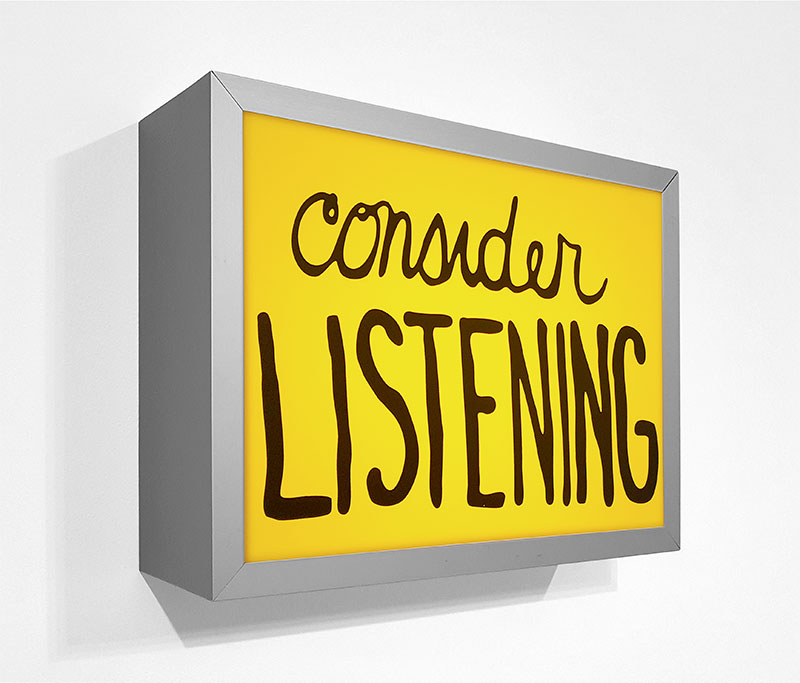
11 3/4 x 15 3/4 x 4 3/4 inches (30 x 40 x 12 cm)
Edition of 25
Signed and numbered on label on reverse with an accompanied certificate
(Inventory #30032)
Exhibited June 23, 2018 – August 3, 2018
11 3/4 x 15 3/4 x 4 3/4 inches (30 x 40 x 12 cm)
Edition of 25
Signed and numbered on label on reverse with an accompanied certificate
(Inventory #30032)
Exhibited June 23, 2018 – August 3, 2018
Antwaun Sargent describes Sam Durant’s work this way: “When highly charged language is isolated and removed from its original context, does it have the same meaning? … [Sam Durant has] appropriated protest signs [and] colorfully reimagined [them as] light boxes … the artist isolates the language of protest as a way to expand its punch, while simultaneously highlighting that there are a range of issues on which the public and art can speak truth to power… To create the signs, Durant searched image archives of protest signs from around the world. He then transferred the handwritten vernacular statements onto colorful monochrome light boxes, typically used for commercial advertisement… Looking at the sign, one is reminded of how, over the course of the Black Lives Matter movement’s existence, the chant’s language has evolved to become more explicit…The statements may be decontextualized, mounted as they are on white walls in a gallery, but Durant brings together many voices seeking justice and equality. By exhibiting the anger, collective yearning, and optimism of the people, they are being heard clearly, even in a gallery.”
The sign Durant uses is like a commercially produced illuminated display. It’s like the type found on the sides of small, local businesses such as convenience stores, restaurants, liquor stores and auto repair shops. It is the type that is so ubiquitous and unremarkable as to be almost invisible in the vernacular landscape. It is made in the most basic and economical way possible: a metal box containing lights with a plastic face on translucent film has been attached.
The text is commercially produced black and opaque. The text is sourced from a photograph, most likely taken of a protest march, sit in, uprising or other event around liberation struggles (the series uses imagery mainly from the 1960s and ’70s but also including recent events). The criterion for selecting the image is both simple and specific. The photo should contain an image of a hand made sign and the text or message on the sign should be general in nature. The message should not refer to any specific event, cause, person or time, in other words, text that could have more than one meaning depending on the context or time in which they are seen. Once the sign has been selected, it is digitally scanned and the text is cropped out of the original picture. The texts is then affixed to the face of the sign so that you have a mechanically reproduced, exact replica of the hand painted original.
Sam Durant is a multimedia artist whose works engage a variety of social, political, and cultural issues. Often referencing American history, his work explores the varying relationships between culture and politics, engaging subjects as diverse as the civil rights movement, southern rock music, and modernism. His work has been widely exhibited internationally and in the United States. He has had solo museum exhibitions at the Museum of Contemporary Art, Los Angeles, Kunstverein für die Rheinlande und Westfalen, Dusseldorf, S.M.A.K., Ghent, Belgium and the Govett-Brewster Art Gallery in New Zealand. His work has been included in the Panamá, Sydney, Venice and Whitney Biennales. His work has been extensively written about including seven monographic catalogs and books. In 2006 he compiled and edited a comprehensive monograph of Black Panther artist Emory Douglas’ work. His recent curatorial credits include Eat the Market at the Los Angeles County Museum of Art and Black Panther: the Revolutionary Art of Emory Douglas at The Museum of Contemporary Art in Los Angeles and the New Museum in New York. He has co-organized numerous group shows and artists benefits and is a co-founder of Transforma, a cultural rebuilding collective project that began in New Orleans. He was a finalist for the 2008 Hugo Boss Prize and has received a United States Artists Broad Fellowship and a City of Los Angeles Individual Artist Grant. His work can be found in many public collections including The Art Gallery of Western Australia in Perth, Tate Modern in London, Project Row Houses in Houston and the Museum of Modern Art in New York. Durant teaches art at the California Institute of the Arts in Valencia, California.
10 Newbury Street, Boston, Massachusetts 02116
617-262-4490 | info@krakowwitkingallery.com
The gallery is free and open to the public Tuesday – Saturday, 10am – 5:30pm